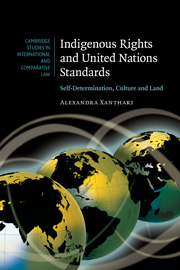Book contents
- Frontmatter
- Contents
- Table of cases
- Table of statutes
- Acknowledgments
- Introduction
- 1 Recognition of cultural membership and implications
- Part I United Nations instruments on indigenous peoples
- Part II Thematic analysis
- 4 Do indigenous peoples have the right to self-determination?
- 5 Indigenous cultural rights
- 6 Indigenous land rights
- Conclusions
- Bibliography
- Index
- CAMBRIDGE STUDIES IN INTERNATIONAL AND COMPARATIVE LAW
6 - Indigenous land rights
Published online by Cambridge University Press: 25 July 2009
- Frontmatter
- Contents
- Table of cases
- Table of statutes
- Acknowledgments
- Introduction
- 1 Recognition of cultural membership and implications
- Part I United Nations instruments on indigenous peoples
- Part II Thematic analysis
- 4 Do indigenous peoples have the right to self-determination?
- 5 Indigenous cultural rights
- 6 Indigenous land rights
- Conclusions
- Bibliography
- Index
- CAMBRIDGE STUDIES IN INTERNATIONAL AND COMPARATIVE LAW
Summary
Introduction
It was not until the latter part of the twentieth century that efforts were made to seriously consider land claims of indigenous peoples and to work towards their resolution. During the 1996 Commission Drafting Group, a representative of the indigenous communities of the Pacific expressed the general position of indigenous peoples:
First of all, it must be legally accepted that we are the first settlers, first dwellers or proprietors of our land. Second, we are a collective group who were imposed upon by uninvited external forces who disrupted the normal march of our history.
For some indigenous communities, land rights are the central claim in their struggle for more protection. Largely, this is because of their special relationship with the land on which they live, a relationship confirmed by the UN Human Rights Committee, the UN Special Rapporteur on Indigenous Issues and ILO Convention No. 169. As indigenous peoples have explained:
The land is the basis for the creation stories, for religion, spirituality, art and culture. It is also the basis for relationships between people and with earlier and future generations. The loss of land, or damage to land, can cause immense hardship to indigenous people.
Land was indigenous peoples' sacred mother, life giver and the source of their survival, and therefore [land rights] were the heart and soul of the draft.
Land rights often have ramifications for the physical survival of the group.
- Type
- Chapter
- Information
- Indigenous Rights and United Nations StandardsSelf-Determination, Culture and Land, pp. 237 - 279Publisher: Cambridge University PressPrint publication year: 2007

